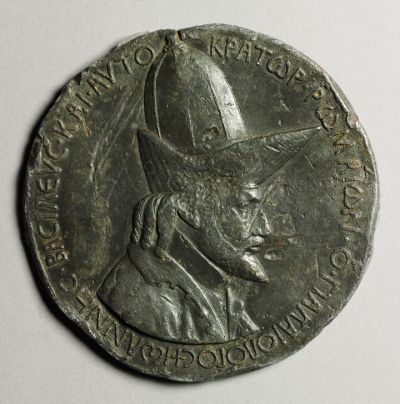Within the Byzantine gallery of the Cleveland Museum of Art may be found a portrait medal cast in lead, not by a Byzantine artist, but by the leading medallist of 15th century Italy, Antonio di Puccio Pisano, commonly known as “Pisanello.” Pisanello has been called “the founder of the modern medal and the greatest exponent of that branch of art.” His portraits in the form of medals are remarkable for their true rendition of what he observed. Pisanello was born in Pisa in 1395 and died in Rome in 1455. Like many Italian artists of the time, he was active in various cities, wherever the commissions took him, and Pisanello’s travels placed him in Verona, Ferrara, Mantua, Milan, Rimini, and Naples.
Pisanello was one of the most distinguished painters of the early Italian Renaissance. He is known for his frescoes, elegant portraits, small easel paintings, and accomplished drawings. From 1435, however, Pisanello became increasingly interested in portraiture in the form of medals. He rapidly became the most important medalist in the first half of the 15th century. He can also claim to have originated this important genre. The fashion for collecting and owning medals came to maturity during this period. This was partly because ancient Roman coins were being discovered in the ground and collected by erudite Italians for their designs and beauty. Like the larger medal, ancient coins had a portrait on the front (obverse) and a different design and inscription on the back (reverse).
A medal is a small portable artistic object, a thin disc, normally of metal, carrying a design usually on both sides. They typically have a commemorative purpose of some kind, either of an event or a person and many are given as awards. They may be intended to be worn, suspended from clothing or jewelry in some way. It was also common during the Renaissance to display them in cabinets as collectibles. They are traditionally cast using moulds, unlike a coin which is struck by dies. Medals are much larger than coins. Pisanello’s medal measures 4-1/4 inches in diameter. Medals were commonly cast in various metals such as lead, bronze or silver or even gold.
The museum’s medal features a portrait not of a contemporary Italian but of the Byzantine emperor, John VIII Palaeologus, who reigned in Constantinople from 1425 to 1448. This design is generally considered to be the first portrait medal of the Renaissance. The question might be asked as to the occasion represented by the medal. Italian city states had a long tradition of mercantile relationships with the Byzantine empire. Venice, Genoa, Pisa, and others maintained colonies of merchants in Constantinople to foster trade. Some 800 years earlier, southern Italy, itself, was part of an expansive Byzantine empire that reached into the Balkans and along the Mediterranean rim. By Pisanello’s time, Byzantium was but a pale shadow of its former glory and was under threat from the expanding Ottoman Empire. Eventually, in 1453, Constantinople, despite valiant efforts, fell to the Ottomans.
Pisanello’s medal was created in response to John VIII’s visit to Italy. The emperor had been invited to attend the Council of Ferrara by Pope Eugenius IV to address the question of unifying the Latin and Greek churches. One of John’s chief motivations for unification was to secure help from the western powers to meet the constant threat to his crumbling empire from the Turks. The emperor arrived in Venice in 1438, where he was met by Niccolò III d’Este and accompanied to Ferrara. The emperor’s retinue is said to have numbered 700. This event allows us to date our medal to 1438-1439.
The obverse of the medal shows the bearded emperor facing to the right, wearing a tall hat with wide upturned brim, signifying his status. His hair falls in corkscrew curls. An inscription in Greek reads: “John, king and emperor of the Romans, the Palaeologus.” Upon his arrival in Ferrara in 1438, John must have been an especially picturesque image to the Italians. According to Vespasiano da Bisticci, the emperor was “wearing a Greek dress of Damascus brocade, very rich with a Greek bonnet, on the point of which was a very fine jewel—a very handsome man with a beard worn in the Greek fashion.”
The reverse side of the medal depicts the emperor on horseback in a rocky landscape passing a roadside cross, perhaps on the way to Ferrara. It is framed by an inscription below in Greek and its Latin equivalent above: OPVS PISANI PICTORIS (the work of Pisano the painter). Most scholars agree that the medal was likely cast in Ferrara.
https://www.lagazzettaitaliana.com/history-culture/8833-a-portrait-medal-by-pisanello#sigProIdf232bcf86b
In January 1439, the Council was moved to Florence at the invitation of Cosimo de’Medici. There, numerous points of theology were resolved, and a decree of union was signed. When John and his delegation returned to Constantinople, the decree was strongly rejected by the clergy and the lay population there and never took effect. He died in 1448, some five years before the collapse of Constantinople to the Ottomans.
The medal representing John VIII Palaeologus is not only a fine example of an art form then reaching its peak of fashion, but also an important historical document recording a sad visit to Italy by a ruler whose empire was about to fall.




